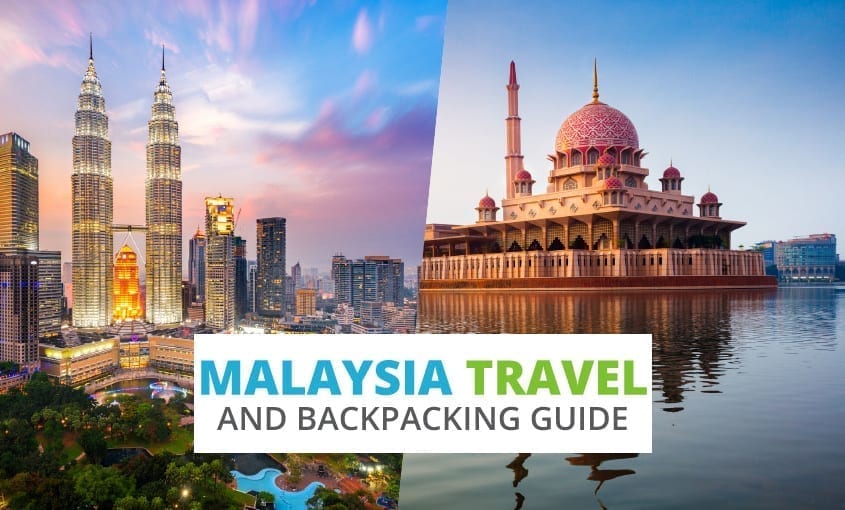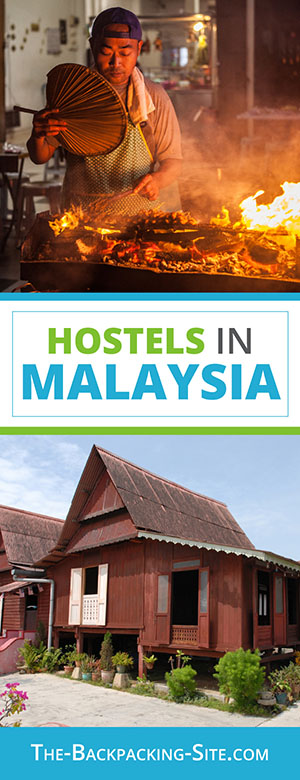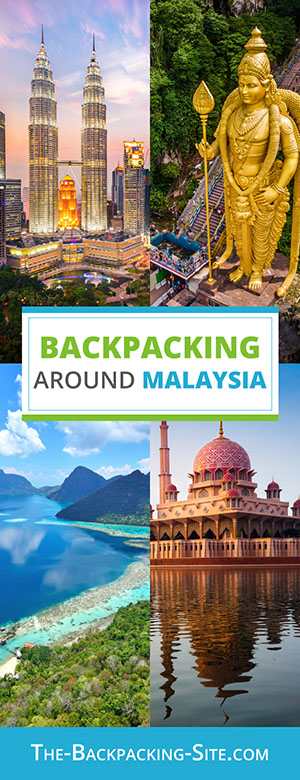
Backpacking Malaysia
Looking for important travel information while backpacking in Malaysia? Here you will find information on working in Malaysia, entry visas, Malaysia hostels, and much more.
Table of Contents
- Facts About Malaysia
- Things to do in Malaysia
- Entry Visa Requirements for Malaysia
- Foreigner Work Permits and Backpacker Jobs in Malaysia
- Malaysia Hostels
Facts About Malaysia
Malaysia is an extremely diverse and exotic country. Occupying the end of the Thai peninsula as a part of Indonesian Kalimantan, it boasts mountainous hinterland, dense virgin rainforests, stunning coastlines and paradisical, untouched tropical islands. In terms of the natural environment, Malaysia is among the best.
Another face of the country is its roaring economy. The Malaysia of today is a prosperous nation and this newly gained wealth is evident in the high-tech, trendy capital city Kuala Lumpur. For the traveller, this is one of the most pleasurable and hassle-free of the Asian countries around which to base a trip.
Malay is the official language of Malaysia, although English and Chinese are also widely spoken. Malaysia was under British administration for a long time and therefore, most foods are also labelled in English.
- Currency Malaysian Ringgit (RM)
- Time GMT/UTC +8 ()
- Language Malay (official), Tamil, English, Chinese.
- Telephone Service Dialling code +60
- Emergency Numbers All services 999
Climate in Malaysia
When deciding the best time to visit Malaysia, weather certainly plays a role. Malaysia is situated in the equatorial zone and for this reason, experiences a perennially tropical climate. Temperatures average 30°C all year round and humidity levels usually hover around the 90% mark.
Hot and humid day times are broken up by short and very intense bursts of torrential rain on a daily basis. At higher altitudes, however, the intense Malaysian tropical climate is somewhat modified. Average temperatures drop considerably in the highland areas and humidity levels become much more bearable.
Malaysia is affected yearly by two rainy seasons, commonly referred to as “the monsoons”. The effects of the monsoons vary in severity across the country: some areas become totally submerged by flooding, whereas mountainous areas are affected much less.
The north-east monsoon generally occurs between the months of October and March, and from May to September, the south-west monsoon sweeps the country. The heaviest rainfalls are experienced in spring and autumn as the monsoon changes direction.
The rains should never deter a visit to the West coast of Malaysia or indeed, the highland hill stations. Weather patterns remain more or less uniform despite the monsoon season. In the morning the sky is usually clear and sunny with rain clouds bringing short showers in the afternoon.
It is rare to have a day without sun, or indeed without showers. It is, however, advisable to avoid the east coast destinations during the rainy season months of November and January if you really want to take advantage of the beaches.
When packing, the golden rule is variation. Pack light summer clothes because heat and humidity are guaranteed, carry a good raincoat or umbrella and an extra warm sweater if you plan on trekking into the hills.
Things to do in Malaysia
Kuala Lumpur
Kuala Lumpur is a city with two faces: its gleaming modern sky-scrapers, alongside the traditional Chinatown and Little India back streets, bustling with street vendors and night markets. In little more than a century, the city has grown to be an extremely important economic centre in Asia.
The high-tech modernism of the new city is symbolised in the famous 88 storey Petronas Towers, that rise an incredible 451.9m above the city. Take the lift to the 41st floor where there is a “Skybridge” viewing point that connects the two towers.
On a very different note, the Sri Mahamariamman Temple in Kuala Lumpur is well worth a visit. It is Kuala Lumpur’s principal Hindu temple. After being greeted by its magnificent gate-tower, you will find a vibrantly colourful place, featuring the most important shrine in the city. Shoes must be removed at the entrance.
Islam is the primary religion on the Malaysian peninsula and hence, for any traveller truly interested in the culture of the country, a trip to the Islamic Museum is compulsory. A spacious, stunning white domed building, the museum houses scale-models of the world’s most important mosques.
Cameron Highlands
Leaving the capital and seeking respite from the bustling Asian city life, a good inland destination is the Cameron Highlands. Situated in the centre of the Malaysian peninsula, the area features a series of hill stations lying at altitudes between 1500-1800m (4920-5904ft). The fertile area is cultivated with tea plantations and walking around the forest trails, beautiful gardens and plantations is a little like stepping back into a forgotten colonial past.
Taman Negara
Every trip to Malaysia should include a trek into the breathtaking wilderness of Taman Negara, an area of dense jungle that provides a haven for many endangered species like elephants, tigers, leopards and rhinos. To have a chance of spotting these animals it is necessary to venture quite deep into the wilderness, and this is best accomplished by taking the boat trip up the river.
If you don’t catch sight of one of the endangered species, it is certain that you will spot snakes, lizards, monkeys, small deer and a plethora of bird and insect species. Taman Negara is among the world’s most ancient primary rainforests. It remained untouched by southward creeping ice caps during the Ice Ages and the forest has also managed to escape major volcanic activity and other geological upheavals.
Perhentian Besar and Perhentian Kecil
Other highlights include a visit out to the twin islands of Perhentian Besar and Perhentian Kecil. These are generally considered to be the most beautiful islands in Malaysia, with expansive, pristine, white sandy beaches. The crystal clear waters surrounding the islands host accessible reefs and are perfect for scuba-diving and snorkeling, both popular activities on the islands.
For something particularly unusual and exotic, make a trip to the “Snake Temple” in Penang. Straight out of an Indiana Jones film, the temple swarms with poisonous snakes, that are heavily drugged with incense to avoid venomous attacks on tourists.
Unique activities in Malaysia
Another good way to get an idea of things to do while backpacking Malaysia is to scan the activities offered by Get Your Guide or Viator. They work directly with local tour operators, so you won’t have to scour the internet or roam around town trying to find the best deal.
If you know your schedule ahead of time, a great insider tip is to buy tickets for major tourist attractions in Malaysia ahead of time. Tiqets has entrance tickets and skip the line passes for major attractions in Kuala Lumpur, Langkawi, Nusajaya so that you can avoid the lines and save that precious time for more exploring.
How to Travel Around Malaysia
The most popular way to reach Malaysia is by getting a flight to Kuala Lumpur (Sepang International Airport 75km from the city). It is possible, however, to fly to other destinations within the country. Penang for example also has international flights.
If you’re flying to Malaysia or plan to take short flights within the country, we recommend using a few different flight comparison search engines. Kiwi is a new favourite among travellers. On average, we have found the cheapest flights to Malaysia with them compared to the other websites out there.
Of course, it is always worth checking Skyscanner to guarantee you’re getting the best deal. Both websites offer great flexible search options, allowing you to search the whole country of Malaysia to find the cheapest airport to fly into, and also see prices for a full month if you’re flexible on travel dates.
Other popular ways to get to Malaysia are overland from Thailand or Singapore or by ferry from Singapore. There are five places where you can cross the Thailand/Malaysia border by road. There is a causeway that can be crossed to reach Singapore, or alternatively, you can take the ferry or the train.
Backpacking Tours in Malaysia
Though part of the fun of backpacking Malaysia is exploring on your own, there are situations, especially when venturing off the tourist trail, when it does make sense to go with a guide or a small group. For these times, a popular option among backpackers is G Adventures. They hand-select local guides to ensure authenticity and quality. This is especially a good option for those travelling Malaysia alone who would like to meet up with like-minded travellers. Their most popular trips in Malaysia are their 11-day Highlights of Sabah & Mt Kinabalu classic tour.
There is no bad time to visit Malaysia, though the East coast beaches are best enjoyed outside the rainy season months of November to March. The capital Kuala Lumpur is hot and extremely humid all year round. The wettest months of the year are March to April and September to November, so travelling outside these months could prove slightly more pleasurable.
Public holidays can be a great time around which to coincide your trip to Malaysia. Despite being more chaotic and crowded than usual, the numerous public holidays can be an exciting time to travel as you can find yourself among the locals as they head out to the beaches and hills.
Be warned, however, Malaysia is predominantly a Muslim country and during large Festivals such as Ramadan, finding restaurants that are open can be a difficult task. Modern and liberal Kuala Lumpur is not affected by the large scale religious festivals.
Health and Safety in Malaysia
Excellent quality of medical care is available in Kuala Lumper, equal to that of Western countries. It is not, however, free and therefore medical insurance is a necessity.
In remote rural areas, medical facilities vary between being scarce and entirely absent. A good medical insurance policy is recommended in the case of serious illness or injury requiring an airlift from a remote area.
Before travel, be sure you are up to date on all routine immunisations. See your doctor at least 4-6 weeks before your trip to allow time for vaccinations to take effect.
Recommended Vaccinations:
- Malaria: Prophylaxis with Lariam, Malarone, or doxycycline is recommended for all rural areas, but not urban or coastal areas.
- Hepatitis A
- Typhoid
- Yellow Fever – certificate of immunisation is required if coming from a yellow fever endemic zone.
- Japanese Encephalitis
- Hepatitis B
- Rabies
- Measles, mumps, rubella
- Tetanus-diphtheria
Entry visa requirements for Malaysia
Citizens of most countries (including the UK and US) do not need to apply for a visa to enter Malaysia providing the trip is for tourist purposes and the length of stay no more than 90 days.
In all cases, a valid passport is required with at least six months remaining beyond the date of entry. Also, all travellers must be in possession of a return or onward ticket and sufficient funds (at least RM250). It is advised that you enter Malaysia on the passport on which you exited your last country of departure, as dual nationality is not recognised.
Unless flying from Malaysia (where it is already tacked onto the ticket price) you will have to pay an RM20 departure tax when flying internationally.
Foreigner work permits and backpacker jobs in Malaysia
To be able to work in Malaysia, it is necessary to apply for a working visa. Tourist visas do not permit legal work, but of course, volunteering is an option.
Teaching English in Malaysia
Alternatively, if you plan to stay for a longer period and manage to get a working visa, a solid work option is teaching English. It is even better if you arrive with a TEFL qualification as you will be in a better position to demand decent working conditions. However, English teachers are in such high demand that even without the TEFL qualification, it shouldn’t be a problem to find work. Work is readily available in private language institutions, public schools and also within companies.
Volunteering in Malaysia
Volunteering work is a definite option in Malaysia and a great thing to do if you really want to spend some time in the country and also want to access areas and situations that are off the beaten track. Big volunteering organisations include; the VSO or Gap activity projects.
Malaysia Hostels and Budget Accommodation

In the capital Kuala Lumpur, all manner of accommodation options are available, though there are few quality budget places for the backpacker. Kuala Lumpur caters more effectively to more moneyed business travellers, with luxury hotels plentiful in the capital. Sometimes these hotels offer a 50% discount, so can be a worthwhile option for the first couple of nights when starting out, or arriving with jet-lag to sleep off.
Most hotels, including the budget/mid-range ones, are situated in the capital’s Golden Triangle district, where most of the large shopping malls and nightlife is clustered. Chinatown is also a good option for the budget traveller and is packed full of cheap hotels and guest houses, though perhaps not an area for the faint-hearted.
Budget room prices hover between 30-75RM mark ). Moving up in quality you can expect to pay 75-200RM.
We have had good experiences finding hostels in Malaysia on HostelWorld. They have the largest inventory of hostels worldwide, and with over 10 million reviews and ratings from other travellers, you know exactly what to expect.
Another good way to find accommodation while backpacking in Malaysia is by checking hotels.com and booking.com. With both sites, you’ll not only find hotels, but also homestays, hostels, and other unique accommodation. We have discovered some great finds and have appreciated the ability to book ahead. You can use their advanced filtering to narrow your results by budget, location score, overall review score, and amenities. Many of the places on booking.com also offer free cancellation, which takes the pressure off the planning phase of your trip.
Useful Links for Backpacking in Malaysia
- G Adventures – small group backpacking tours in Malaysia, great for solo travellers or for those interested in a more adventurous trip which would require a guide
- GetYourGuide – a collection of local tours and things to do in Malaysia. Also offers Skip the Line tickets for crowded attractions
- HostelWorld – #1 search website to find a hostel in Malaysia. Thousands of hostels and millions of reviews from fellow travellers.
- Booking.com – commonly used booking site in Malaysia. Hostels, hotels, and other unique accommodation with advanced filtering and millions of reviews
- Travel Insurance – read our comprehensive overview of Travel Insurance and some recommended providers for backpacking Malaysia
There you have it, the ultimate Malaysia backpacking guide. We hope you have found all the information you need for backpacking around Malaysia.
Next up:
Liked this article? Share it with others who might be after the same information!


Leave a Reply
Want to join the discussion?Feel free to contribute!